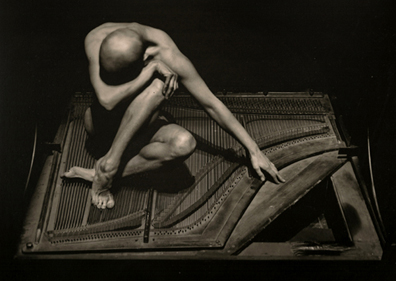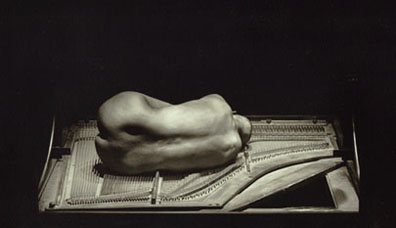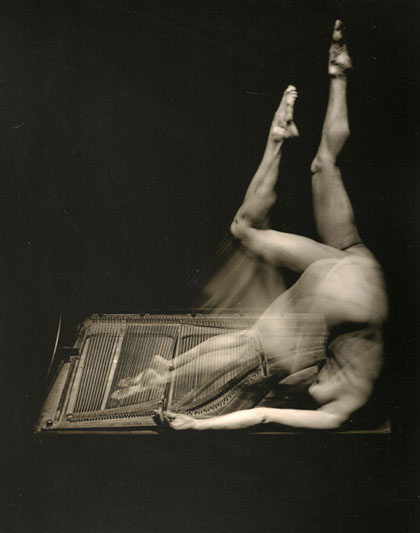 |
|
Let’s start describing what the audience can see: the scene is lit up by darkness; thin layers of rarefied mist rest at head height. For the occupants of the higher stalls, the mist and the instrument overlap. Unlike the people in the first rows for whom the scene seems to be divided into two levels. The searchlight perpendicularly originates a narrow pyramid whose base perfectly corresponds to the square base of the harp. When talking about “harp”, I mean the metallic structure which holds together the strings of a broken, even mangled, piano. You’ll come across this word many times in this paragraph. The harp, which is originally placed upright in the body of the piano, is now placed on the ground. Its rear part is slightly heightened so that the audience can clearly distinguish all the bunches of strings. A watchful eye can see three types of strings. The strings playing low sounds are rolled up; they are thick and give a sensation of an easy opposition to the performer. They are the strings of the lower octaves; their tone is heavy and physically perceptible when they are played with force. On the contrary, if they are played gently, they can be compared to beetles freely able to fly. In the centre of the harp, there are the middle strings, which are thinner and lighter; the performer exerts his best efforts in playing them. They produce high tones, but they can easily play a lower tone, similar to that of the previous strings. We will talk later about the third type of strings, which create the highest frequencies.
The light which was illuminating the stalls suddenly turned off, or at least this was my impression.
A body appears in a faint light. Now we can finally recognize it: a flesh-coloured mass, darkened by black earth, was placed on the harp as a dead body, a trunk without arms or legs. Its head partially hidden by its bent back seemed to be cut off. I am almost fascinated by it. The square base seems to imprison the fleshy mass, there is no escape. It has been drawn there. How to find a way out of it? Who? Is it me I’m looking at? Is there a mirror or what? Finally, all is revealed. The light gradually gets brighter, indirectly, like the light of the moon through a window. I’m focusing my attention on the body: the harp, the body, the light. A piece of flesh is moving, now. A thigh, if it is a thigh, is separating from the trunk and is rising, keeping the leg, which is suddenly visible, in a horizontal position.
It is a stump with a prosthesis. No, it is not a prosthesis at all. It is a limb which originates to take its own shape and life. The general sentiment is that of seeing a substance-body, as an old trunk from which, in accordance with the climate conditions, strange fungiform emerges.
I lower my head, not because I am discouraged by what I can see, but because what I can see makes me sink. Now, I’m staring at the floor. I am taken over by a crushing sensation. I try to pull myself together... the leg has disappeared again, it has been reabsorbed.
I come back to the story. Like in a movie whose shot was speeded up in order to obtain a slowing effect during the show, I can see three phases: at first, an arm and a hand raise to the air, as to get rid of something or to drive its stink away, or maybe, I think, to keep their own nature at a distance. Something unexpected happens. The white keyboard of a vertical piano suddenly appears out of darkness; it has been a furtive presence until now. And the sounds we had heard when the limb initially moved are now visible, originated by I wander what kind of mechanism: the white and black keys chase each other on the keyboard and finally fall silent. The attention is focused on the body again. It is fighting against the force of gravity in order to rise, I think, its pelvis and its powerful glutei, arching its whole mass. The image is not clear: even a little slip can make you think that the body, once animated by the intention to be vital, is dead again. The wait is short.
And it gives me the opportunity to think. Yes, it’s true, I’m watching the scene, but the images are now lengthening as in a long shot sequence, and they are taking their definitive shape. Although the sudden thrust to what seem like shoulders forces the flesh upright, any doubt disappears. Her back is partially hidden by thighs in order to give the opposite effect: a legless body with its head hidden underground.
It is a woman. We can see her. The feminine figure, once sitting, stands up on the harp, as if to defecate. Then, she ferociously leans her back forward and becomes a creature with only legs and glutei. Her orifice is hidden due to a subtle play of shadow and darkness.
Now I am calm, as if I am back to reality, the reality of a body which measures and realises new forms of flesh. Her pelvis turns and her mass moves to the front of the harp. She is curled up, she hugs her knees, and her glutei are on the strings. Finally, all is still. A face appears – for the first and last time. The producer of the show leads the figure to the recognition of itself, of its physicality, of its body which is now showing its prosthesis. I am fixing my eyes on the stoneware tiles, on the floor, as if the glance I casted was still there.
Jerking and with dragging movements, the woman reaches the edge of the harp; she stretches out one foot, then the other one, next to the former. Her feet lever, her thighs contract and she stands up, which is unexpected but not totally unforeseeable. On the other hand, her head leaned forward, covering her look, presents us a new, quick creature. The woman goes around the harp with a dog’s gait: now she’s looking beyond the horizon, from behind, as to study the profile of the bunched strings; her low, sharp look is searching a way out or maybe the best spot to attack. That is what happens: her hand appears from darkness, followed by her arm, and they rest on the harp, on the middle strings. Her clenched fist now shows her offensive fingers which lacerate and creep. The resulting sound is crude, sanguine. The animal, out of its den, seems to better understand its nature. Sinuous like a cat, sometimes like a beetle slithering towards salvation, it finally emerges and boldly hit the strings with its sharp hand. Now the sound mangles the instrument, the strings vibrate and overlap harmonic and blurred frequencies. It springs forward and its face presses the strings, deadens the sound and stops it definitely. I am upset by this approach: a body acts on the mangled instrument, sometimes gently, sometimes rudely; however, the closeness of both instrument and performer seems to respect a precise pattern, like in a harmonic score. I am thinking of Rameau, of his “sound body”, of his questions about musical harmony. I am thinking of equal temperament, the compromise which seems to save the instrument, but surely leads it far from its natural melodies. I wonder if the performer is really conscious of it.
Something must have happened because the figure is now on the other side of the harp, it stretches out its foot as to get on it. Hesitating for a moment, it is now on the bunches of strings and it put violently its head to the ground, thus showing its whole back starting to free itself from fictitious laces: the effort is big but nobody perceives it; it is an elastic substance which recoils and extends.
At these junctures, I have never described the other protagonist, an upright piano which is placed in the close proximity of the harp.
It is now evident that the figure interacts directly with the instrument-automaton: the accelerations of the woman’s movement always correspond to glissandi, which are now slow now fast, in intensity and in frequency.
There is a tacit agreement between them, the former always anticipates the latter, bringing it along or rejecting it. We come across a very peculiar organism. I am troubled by it. It is animal machinery, an animal-woman, a soulful instrument. I cannot help thinking of Heidegger’s Urphänomen. I come back to the scene: I am running the risk of missing it.
The figure is curled up again, it seems to be looking for some rest or for the concentration to start again and put an end to its show, as we can see later.
The left foot places behind the right one and drag the leg with it; the pelvis slightly turns; the left arm takes slowly but firmly a solid part of the metallic shell of the harp. The shoulders stretch out in the same direction and bring the head to a hole on the harp, until now unnoticed.
The head slips inside the hole and drags the rest of the body, the pelvis and the legs until they are forced upright. In other words, the body is upside down, upright, the head downwards, the legs upwards. The shoulders, which rest on the two sides of the harp, let the head hide and the woman becomes – apparently – easily upright.
The thighs are now clenched on the abdomen, the legs horizontally laid recoil some millimetres at a time. The muscle mass dislocation is very precise, almost crude.
Here is the turning point. The body seems to bounce; the pelvis contracts with violence till the legs are upwards, very upwards. And the piano starts its mad rush; its keys chase each other rapidly, precisely, in multiple chords, major and, sometimes, diminished triads. The keyboard seems to be a slave to the woman and her movements. What the audience can perceive is two instruments acting in unison.
The legs excitedly pursue their dance and seem to run from the body: the new figure is only made up of legs, or better still the legs seem to be the animal.
The sound is prodigious; complex glissandi alternate to single chords or, when the movement calms down, to solitary notes sometimes incomprehensibly repeating themselves. The sound mass seems to take shape according to its own rules; as the story goes on, the audience is sent through a whirl of variations in intensity and frequency, corresponding with the woman’s movements, appeasements and accelerations.
I would like it to continue; she is already overcome by tiredness and the figure loses its strength, as if her vital power is switched off, and she falls on the harp.
Darkness prevails, suggesting that the woman may be there forever, next to her harp, in her place of origin, in her den. |
| |






